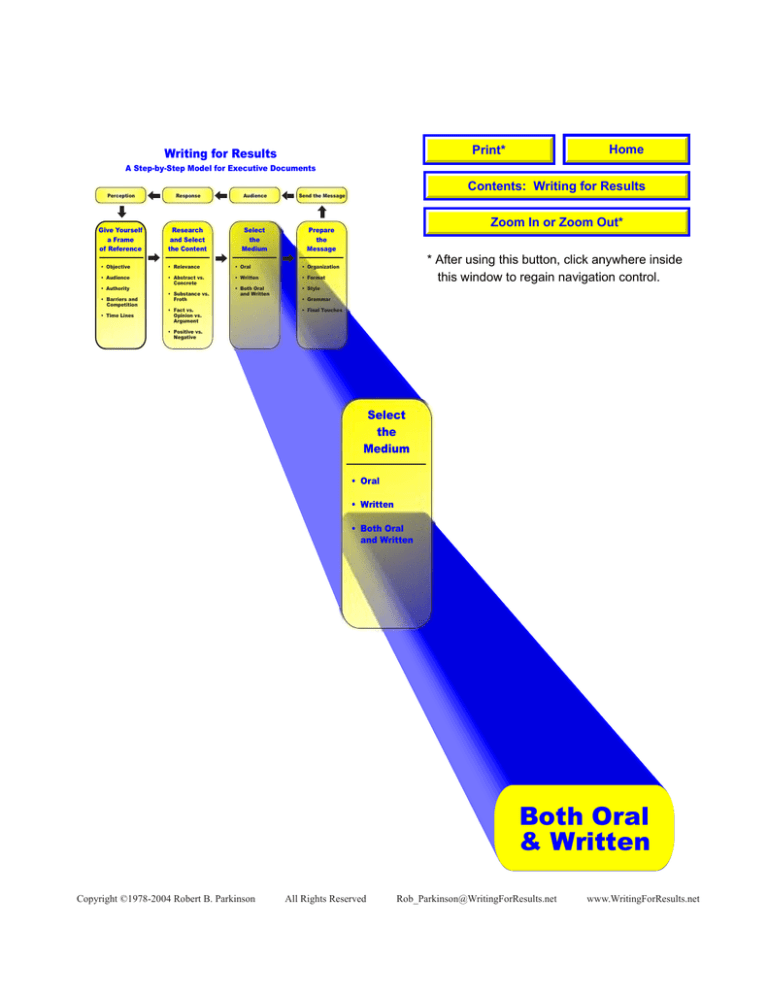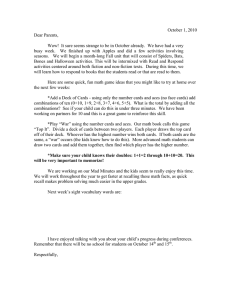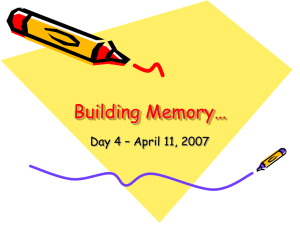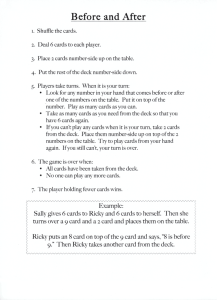
Home
Print*
Writing for Results
A Step-by-Step Model for Executive Documents
Contents: Writing for Results
Perception
Response
Audience
Send the Message
Give Yourself
a Frame
of Reference
Research
and Select
the Content
Select
the
Medium
Prepare
the
Message
• Objective
• Relevance
• Oral
• Organization
• Audience
• Abstract vs.
Concrete
• Written
• Format
• Both Oral
and Written
• Style
• Authority
• Barriers and
Competition
• Time Lines
• Substance vs.
Froth
• Fact vs.
Opinion vs.
Argument
Zoom In or Zoom Out*
* After using this button, click anywhere inside
this window to regain navigation control.
• Grammar
• Final Touches
• Positive vs.
Negative
Select
the
Medium
• Oral
• Written
• Both Oral
and Written
Both Oral
& Written
Copyright ©1978-2004 Robert B. Parkinson
All Rights Reserved
Rob_Parkinson@WritingForResults.net
www.WritingForResults.net
Title Page
Forum
-2-
Combinations of
Both Oral
And Written Media
Oral and written media have their pros and
cons. By combining the two, however,
you can often get the best of both worlds.
For example, in a meeting you could hand
out a chart or diagram that helps to bring
home a point that you are making. In
advance of a telephone call, you could email some text that you need to discuss. In a workshop, you could use a flip chart to
write down key points from a presentation, and then tape the sheets to the wall.
Slide deck presentations have gained great popularity in recent years. That in itself has
pros and cons. If used properly, a slide deck can be an excellent complement to a
presentation. If used improperly, however, a slide deck can be little more than an irritant.
Slide decks have become a pet peeve of mine, so I am going to dwell on them for a few
moments. I have sat through too many presentations where a slide deck has been used as
a type of teleprompter for the text of a speech. That’s to say the presenter writes out his
or her presentation as a speech, and then creates slides out of the speech. The presenter
then reads the slides verbatim off of the screen. That is an abuse of a slide deck.
Instead of carrying a speech verbatim, each slide should carry only three or four main
points from a given part of the presentation. The presenter should then elaborate on those
points orally. The slides serve as a guideline to help listeners keep track of where they
are in the course of a presentation. After the presentation, the slides could be handed out
to jog participants’ memories about what was said. They might also be handed out
beforehand so listeners can make notes on them during the presentation.
Another use of slides can be to present illustrations, charts or tables that cannot be
presented orally. That is an excellent use of slides. However, copies of the slides should
also be provided as handouts, either before or after the presentation.
A complement to a slide deck might be briefing material sent out in advance. That
material could provide insight into concepts that must be understood in order to grasp the
slide deck presentation.
Title Page
Forum
-3-
That leaves four elements of a slide deck presentation, each of which has a distinct role:
• advance reading material;
• the slide deck presentation;
• the oral presentation;
• handouts of the slide deck, either before or after the presentation.
Keep those distinct roles in mind as you are preparing material, and aim to ensure that
those roles do not overlap.
Next Volume: Prepare the Message




